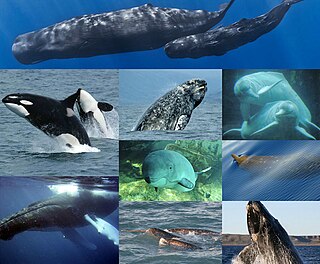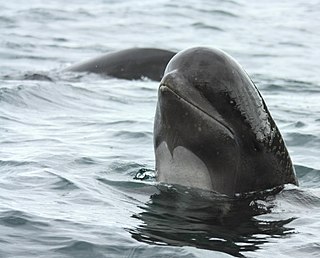
The blue whale is a marine mammal and a baleen whale. Reaching a maximum confirmed length of 29.9 meters (98 ft) and weighing up to 199 tonnes, it is the largest animal known ever to have existed. The blue whale's long and slender body can be of various shades of greyish-blue dorsally and somewhat lighter underneath. Four subspecies are recognized: B. m. musculus in the North Atlantic and North Pacific, B. m. intermedia in the Southern Ocean, B. m. brevicauda in the Indian Ocean and South Pacific Ocean, B. m. indica in the Northern Indian Ocean. There is also a population in the waters off Chile that may constitute a fifth subspecies.

Cetaceans are an infraorder of aquatic mammals that includes whales, dolphins, and porpoises. Key characteristics are their fully aquatic lifestyle, streamlined body shape, often large size and exclusively carnivorous diet. They propel themselves through the water with powerful up-and-down movement of their tail which ends in a paddle-like fluke, using their flipper-shaped forelimbs to maneuver.

The southern right whale is a baleen whale, one of three species classified as right whales belonging to the genus Eubalaena. Southern right whales inhabit oceans south of the Equator, between the latitudes of 20° and 60° south. In 2009 the global population was estimated to be approximately 13,600.

The spectacled porpoise is a small to midsize porpoise indigenous to the Southern Ocean. It is one of the most poorly studied cetaceans, partly due to its remote range in the southern ocean. What little is known about this porpoise species has been gathered mainly from stranded individuals, and a few observations of living animals made at sea.

Hector's beaked whale, is a small mesoplodont living in the Southern Hemisphere. This whale is named after Sir James Hector, a founder of the colonial museum in Wellington, New Zealand. The species has rarely been seen in the wild.

The short-finned pilot whale is one of the two species of cetaceans in the genus Globicephala, which it shares with the long-finned pilot whale. It is part of the oceanic dolphin family (Delphinidae).

The long-finned pilot whale is a large species of oceanic dolphin. It shares the genus Globicephala with the short-finned pilot whale. Long-finned pilot whales are known as such because of their unusually long pectoral fins.

Dall's porpoise is a species of porpoise endemic to the North Pacific. It is the largest of porpoises and the only member of the genus Phocoenoides. The species is named after American naturalist W. H. Dall.

The four-toothed whales or giant beaked whales are beaked whales in the genus Berardius. They include Arnoux's beaked whale in cold Southern Hemispheric waters, and Baird's beaked whale in the cold temperate waters of the North Pacific. A third species, Sato's beaked whale, was distinguished from B. bairdii in the 2010s.

The melon-headed whale, also known less commonly as the electra dolphin, little killer whale, or many-toothed blackfish, is a toothed whale of the oceanic dolphin family (Delphinidae). The common name is derived from the head shape. Melon-headed whales are widely distributed throughout deep tropical and subtropical waters worldwide, but they are rarely encountered at sea. They are found near shore mostly around oceanic islands, such as Hawaii, French Polynesia, and the Philippines.

The hourglass dolphin is a small dolphin in the family Delphinidae that inhabits offshore Antarctic and sub-Antarctic waters. It is commonly seen from ships crossing the Drake Passage, but has a circumpolar distribution.

Cetacean bycatch is the accidental capture of non-target cetacean species such as dolphins, porpoises, and whales by fisheries. Bycatch can be caused by entanglement in fishing nets and lines, or direct capture by hooks or in trawl nets.

Perrin's beaked whale is part of the toothed whale suborder and is one of over 90 known cetaceans in existence today. Beaked whales are part of the family Ziphiidae, which are the second most diverse group out of all marine mammals with over 20 species currently recognized. Although diverse, little is understood about these timid, deep divers that can dive for up to two hours. The whales are partially named after their beak shaped jaw, which extends from their small head. The genus name Mesoplodon comes from the Greek meanings of meso- (middle), - hopla (arms), - odon (teeth), and may be translated as 'armed with a tooth in the center of the jaw'.

The spade-toothed whale is a very little-known species, the rarest species of beaked whale. It was first named from a partial jaw found on Pitt Island, New Zealand, in 1872; reported and illustrated in 1873 by James Hector, and described as a new species the next year by John Edward Gray, who named it in honor of Henry Hammersley Travers, the collector. This was eventually lumped with the strap-toothed whale, starting as early as an 1878 article by Hector, who never considered the specimen to be specifically distinct. A calvaria found in the 1950s at White Island, also New Zealand, initially remained undescribed, but was later believed to be from a ginkgo-toothed beaked whale.

The southern bottlenose whale is a species of whale, in the Ziphiid family, one of two members of the genus Hyperoodon. Seldom observed, the southern bottlenose whale is resident in Antarctic waters. The species was first described by English zoologist William Henry Flower in 1882, based on a water-worn skull from Lewis Island, in the Dampier Archipelago, Western Australia. They live in deep ocean waters over 1000 meters.

Bernd Gerhard Würsig is an educator and researcher who works mainly on aspects of behavior and behavioral ecology of whales and dolphins. Much of his early work was done in close collaboration with his wife Melany Ann Würsig, and they have published numerous manuscripts and books together. He is now Professor Emeritus at Texas A&M University, teaching only occasionally but still involved with graduate student and other research. He is especially active with problems and potential solutions concerning Indo-Pacific humpback dolphins, Sousa chinensis, in and surrounding waters of Hong Kong.

Marine mammals are a food source in many countries around the world. Historically, they were hunted by coastal people, and in the case of aboriginal whaling, still are. This sort of subsistence hunting was on a small scale and produced only localised effects. Dolphin drive hunting continues in this vein, from the South Pacific to the North Atlantic. The commercial whaling industry and the maritime fur trade, which had devastating effects on marine mammal populations, did not focus on the animals as food, but for other resources, namely whale oil and seal fur.

William F. Perrin was an American biologist specializing in the fields of cetacean taxonomy, reproductive biology, and conservation biology. He is best known for his work documenting the unsustainable mortality of hundreds of thousands of dolphins per year in the tuna purse-seine fishery of the eastern tropical Pacific. This work became a primary motivation for the U.S. Marine Mammal Protection Act (1972). His work on cetacean taxonomy was acknowledged in 2002 when a newly recognized species of beaked whale, Perrin's beaked whale, which was named in his honor.

Lisa Taylor Ballance is an American marine scientist who is Director Marine Mammal Institute and Endowed Chair for Marine Mammal Research at Oregon State University.



















